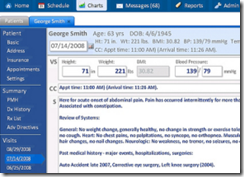Neither of those sound like good news for Oracle Health. After the lofty proclamations of the last couple years. still…
Monday Morning Update 1/5/09
From SQL Goddess: "Re: American CareSource. I thought this was interesting, having never heard of the ancillary care networking business." Link. The Dallas-based American CareSource (warning: the horrid white-on-puke-green color scheme will give you an instant migraine) had the best performing stock of North Texas companies in 2008 with 120% appreciation and a $105 million market cap. It contracts with labs, dialysis centers, and imaging centers to offer their packaged services to small insurance companies and employers. The CEO says it deals with the best and cheapest ancillary providers. "Do you really need 15 imaging centers in North Dallas? How about five that offer the best quality and best prices?" Somebody’s buying it (literally): the company handled 500 claims annually three years ago and is doing 550,000 now, with good prospects in a cost-cutting healthcare environment.
From Topexecit: "Re: Microsoft getting ready to lay off 17% of staff." Link. Rumors are flying that Microsoft will have massive layoffs on January 15, with up to 15,000 employees getting the axe. I don’t doubt that layoffs could be imminent with Q2 reports due on January 22, but despite a plethora of gaffes, MSFT is still doing OK in some markets. And, a number that high would surely have triggered firmer and more numerous leaks of what’s about to happen, not just one guy posting on an obscure tech site that starts ping-ponging around. On the other hand, as I’ve always said, terrible market conditions are a great time to get rid of deadwood, announce all the previously hidden bad news, and make all the tough but unpopular decisions.
From Garrnut: "Re: Partners. Getting skewered by the Boston Globe. This is the third article in a series." Link. The opening sentence about the Partners-Blue Cross insurance cost agreement gives the conclusion away: "It was the gentleman’s agreement that accelerated a health cost crisis." The article claims that Partners got a 75% increase in insurance rates since 2000, forcing other insurers to give it similar increases and encouraging competing hospitals to to seek the same rate, creating inequity, delivering only a tiny percentage of expected cost savings, and leaving duplicative services intact between the two formerly competing hospitals. Deeper into the article, however, is a key fact: Partners has never had a margin greater than 2% and makes a good bit from investments, so its prices aren’t out of line. Here’s some cold water on that, though, from none other than IHI’s Don Berwick, who worries about the inarguable fact that medical oversupply creates its own demand: "When Partners decides to expand . . . the prediction would be it will not add to the well-being of the population. It will add to cost." My opinion: we’re back to the "exactly how well do we want our hospitals to do financially" argument, where everybody’s proud of the the local hospital, its highly compensated executives, and its fancy buildings as long as they’re not the ones directly paying for them. All of that was probably inevitable when the industry turned to the "business model" instead of the "charity model" of yesteryear, encouraging hospitals to run like businesses instead of charitable and religious missions.
From Lupe Velez: "Re: Blueware. A quick check of LinkedIn reveals the CEO is Rose Harr, formerly with IBM. Businessweek.com confirms that and lists David G Holland, formerly with Genesys Health Systems, is COO. I can’t figure out what they offer either." Someone sent over another announcement from them, but I’ve lost interest.
Several people have told us we should write more for the physician office audience, so we’ve started an HIStalk-like site for them called HIStalk Practice. Coverage here won’t change a bit, so for the majority of HIStalk readers who find its ambulatory EMR and related coverage deep enough, then don’t worry about reading it. Otherwise, check it out, sign up for the e-mail updates on that page, and watch for some new contributors who will be helping us write about medical practice IT topics (and let me know if you’d like to contribute).
Most folks are back to work, so I’m ready for your submissions for Wednesday’s Readers Write and suggestions for "An HIT Moment with …" subjects. HIMSS is coming up before you know it, which means (thankfully) that lots of folks will be asking about HIStalk sponsorship, HIStech Reports, text ads, etc., so time is running short for prospective sponsors who want to get on board (that’s not a sales pitch, just a statement of reality that, if it’s like past years, we won’t be able to accommodate the laggards).
I put in some significant Wii time over the holidays, with this conclusion: if all-but-canonized Saint Barack Obama really wants to spend $25 billion of taxpayer money to buy EMRs for doctors who don’t really want them, he should nationalize the Wii Fit programming team to write a free EMR (it’s nearly a PHR already). I didn’t get the Wii thing until I tried it. No wonder they can hardly give away the Playstation and Xbox. As to the first part of my conclusion, my upcoming Inside Healthcare Computing guest editorial is called Buying Doctors Systems They Don’t Want: Why Even Detroit’s Bailout is More Progressive than the HIMSS EMR Welfare Program.
Speaking of sponsors, the last couple of weeks have seen two of them involved in what should be great acquisitions: Novo Innovations was picked up by Medicity and Premise will become part of Eclipsys. It’s really surprising how many HIStalk sponsors have been involved in rewarding acquisitions over the years (that’s not always good for me, of course, since one sponsor acquiring another means I lose one). Inga brought up the fact that a disproportionate number of our sponsors are top ranked in KLAS as well. I don’t understand it, but it’s interesting.
It’s HISsies time! (for either the fifth or sixth year — I can’t remember). Since the voting covers all of 2008, it makes sense to open up the nominations now while that generally awful year is still fresh in your mind. Please fill out the 20-category nomination form. Everybody has fun with the final voting, which will follow in a couple of weeks, but it’s the nominations that make it interesting. As always, I’ve thrown out a few of the less-interesting categories and replaced them with some fun new ones. Which vendor will be acquired in 2009? Who’s the best healthcare CIO? Who will get The Pie? You tell me.
Listening: Elf Power, Athens-based psychedelic indie rock. For all you Misys-Allscripts folks in Raleigh, they’re kicking off their US tour in Chapel Hill on January 21.
It appears that predictions were correct: Obama names healthcare IT as one of the key elements of his economic recovery plan.
The York VA Medical Center (TN) found that it had performed colonoscopies using possibly contaminated equipment, so it used its EMR to identify affected patients to offer them follow-up care (hopefully not a free repeat colonoscopy).
Jackson-Madison County General Hospital (TN) avoids layoffs by cutting back on discretionary spending, including "software packages."
I’ve chided "free EMR" vendor PracticeFusion for what sounded like wildly inflated marketing claims, but I have to admit that its 2.0 screen shots look pretty good. Lots of docs have signed up, although I haven’t seen proof that they’re actually using it fully.
Newspapers love "first baby of the New Year" stories, which I’ve previously observed always seem to involve young, unmarried, and unemployed parents (often just one) who get a bunch of promotional samples from local businesses hoping for free PR. My local paper didn’t let me down this year and neither did most of the newspapers I checked – how about yours?
I mentioned a fascinating profile a few months ago about Kaiser informatics pioneer Morris Collen, MD, who’s 95 and still working. Here’s an even better article from the LA Times. He works on clinical decision support and is writing a book to be called The History of Medical Informatics: The Clinical Support Systems.
Hospital layoffs: Albemarle Hospital (NC); Cambridge Health Alliance (MA); Also: University of Maryland Medical Center asks employees to take unpaid time off to avert a budget crisis.
Healthcare Association of New York State, which pays its CEO $500K according to tax records, launches a "Help Your Hospital" Web site to enlist public support for "vital funding" as the governor tries to cut costs (emphasizing lost jobs more than anything else). It also offers a HIMSS-like closed loop in which vendors are encouraged to buy corporate sponsorships or host the ever-present golf tournament in return for access to its members: "What value does your organization place on networking with more than 550 not-for-profit health care providers? How can you establish a powerful presence and make critical connections with these key decision-makers?" One of its surveys claims that New Yorkers would overwhelmingly rather see their taxes increased than to cut healthcare costs of any kinds, which would be a lot more believable if it were on a ballot and not on a special interest group’s survey.
Odd hospital lawsuit: a Pennsylvania woman is suing a local hospital for allegedly using her image in commercials without her approval, claiming invasion of privacy and being "deprived the value of the exclusive use of her likeness."
And another: a prostate surgery patient sues Shawnee Mission Medical Center, claiming the operating table malfunctioned during the procedure and permanently injured him when it dumped him to the floor. The hospital was previously sued by a patient who claims he was paralyzed and his neck broken when an X-ray table dropped him on the floor while he was sedated.
Ed McMahon files papers against Cedars-Sinai, demanding a protective order for the privacy of his medical records as part of his lawsuit for what he claims is medical malpractice.
Memorial Hermann yanks the name of its $3 million donor Roger Clemens off its sports medicine institute, citing reasons other than the obvious one that he’s been irreparably linked to his denied steroid use (or the claims by a woman that the married Clemens had a longstanding affair with her starting when she was 15).
HERtalk by Inga
Parents magazine names The Children’s Hospital of Philadelphia the nation’s best pediatric hospital.
A Juarez hospital opens a sales office in El Paso to recruit patients and help them navigate medical tourism issues.
John C. Lincoln Health Network and Mayo Clinic (AZ) end their family-practice training programs due to funding issues. Lincoln Health estimates 2007 losses from the program were $650,000.
Hershey Medical Center monitors infection outbreaks via a computerized system. The software provides staff with quick charts and graphs illustrating how many patients within a particular unit are infected and which lab specimen contained the germs.
Good news from Allscripts-Misys. The company revises its Q1 non-GAAP net income to $15.4 million from $13.4 million.
The Detroit News cites CareTech Solutions as one of the bright spots for Michigan’s tech industry. Though the state has lost 6,100 positions over the last year, CareTech has added almost 150.
Music purist Mr. H claims he has done nothing to contribute to this trend, but I’m not so sure. Vinyl record sales double from 2007 to 2008, while CD sales fell. I actually still have a record player, though it’s been 10 years since I touched it (obviously I am not an audiophile). Now I’m wondering if I still have that REO Speedwagon album somewhere.
In Tennessee, e-prescribing increases 127% over the previous year.








RE: The HANYS CEO Salary
He is probably envious of the multimillion dollar salaries that some of his member CEOs earn. Gee, I really missed the mark. When I went to get my MHA it was for the purpose of helping a hospital and the clinical staff be able to treat its patients more efficiently. I guess I was old school.
I have to laugh when I read the reasons for these high salaries and they seem like they parrot the reasons we have to pay so much to the people who got us into this financial mess.
First Baby of the year:
http://www.azstarnet.com/allheadlines/274198
I am posting more on Twitter than my blog these days. Feel free to follow me: http://www.twitter.com/candidcio
First baby, sort of ..
http://www.newsobserver.com/news/durham/story/1352343.html
That “2% profit” number mentioned for Partners needs to be taken in context. Like most NPF hospital delivery systems, there are plenty of ways to massage that number to make it much more palpable to potential critics that the a NPF is making too much money to be considered granted tax-exempt status under 501(c)(3).
I know that this has been a real pet peeve of Grasserly in Congress and that the IRS sent out questionnaires last year to over 500 NPF hospitals to inquire about several important issues (e.g., community benefit, executive compensation) the IRS has used in the ruling guidelines to specify what is/what isn’t a NPF hospital.
Also very interested in see if the FTC (which basically was a neutered and inept agency under the Bush administration the last 8 years) gets some real teeth and starts to really challenge certain mergers again including healthcare providers just like they did in the late 1990s. The Boston Globe article does a good job of how Harshberger (who was the MA State Attorney general at the time of the merger to form Partners) basically gave it a wink-and-a nod along with Weld.
RE MHA: Perhaps the era of hospital administrator is passing the way of the clergy. If the market wants aggressive highly paid MBAs then the MHA programs should consider closing. MBA with a concentration in healthcare TARP would rule! Sister Mary warned us all saying “no money, no mission.”
It becomes apparently depressing attending these ACHE regional meetings listening to a bunch of highly education middle age MHAs crying over spilled milk that they have been passed over more times than statistically possible for CXO positions in their own communities. Hired guns from out-of-state always seem get the jobs because the healthcare CXO market is so opportunity narrow with a choice of MBA vs. MHA from around the country. Look at the resumes of a typical MHA and see how he/she has to travel around the country every 2 – 3 years for a bigger and better position.
It was a slow week in HIT!
Well, it’s not HIT, but since you brought it up…
http://www.childrensdefense.org/site/DocServer/state-of-americas-children-2008-report-moments-and-each-.pdf?docID=9082
According to the children’s defense fund, every 21 seconds a child is born to an unwed mother; every 33 seconds a child is born to poverty; and every minute a child is born to a teen mother. Oh, and every 39 seconds a child is born without health insurance. Why should New Year’s Day be any different?